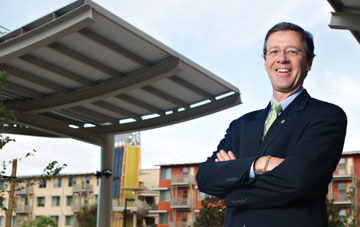Volume 29 · Number 2 · Winter 2012
UC Davis West Village: Overcoming Obstacles

John Meyer, vice chancellor for Administrative and Resource Management, says it took a village to plan and build UC Davis West Village.
(Karin Higgins/UC Davis)
There were many times that UC Davis West Village looked like it might never happen. Just ask John Meyer.
"We thought the project was dead every six months or so," said Meyer, the vice chancellor for Administrative and Resource Management.
Both the regulatory and financial challenges — at a time when the private real estate market was in upheaval — were extraordinarily difficult to overcome. "I think I've suppressed all the bad memories," he said with a grin.
Some of the hurdles along the way included how to finance the project, how to deal with utility regulators and the upfront costs of installing so many solar panels.
"We were thinking differently than anyone before," Meyer said, "so our plans were novel to the regulatory and lending environments. We created the zero net energy model before we knew how difficult it would prove to build."
Planning for West Village began more than 10 years ago, prompted by the shortage of affordable housing in the city of Davis. Once, there were protests against the proposed project — now the surrounding community has largely embraced it. After all, it is an example of the campus accommodating its own housing needs in a thoughtful, sustainable way rather than expecting the city to do so.
"We designed it as a 'live-where-you-work' type of community," said Meyer, noting that many people and units on campus helped in the effort from start to finish. "It took a village to plan and build UC Davis West Village."
Early on, plans did not call for the zero net energy feature. It was simply envisioned as a way to make desperately needed housing available to students, faculty and staff, Meyer said.
Then one day, Bob Segar, assistant vice chancellor for campus planning, talked to his wife, Jenifer, also a planner, about the project. She encouraged him to "shoot higher and push the envelope for total energy use" at West Village.
That sparked Segar and his colleagues to commission the UC Davis Energy Efficiency Center to develop the first energy strategies for West Village and attract the necessary partners to make it happen. Professor Andy Hargadon, the center's founding director, described West Village as a "new way of approaching sustainability that is both affordable and effective."
Hargadon, a professor of technology management at the Graduate School of Management who holds the Charles J. Soderquist Chair in Entrepreneurship, explained that most sustainability technologies are not economically viable on their own. However, West Village brought those separate pieces together in a way that worked financially, he noted.
Segar said West Village has already received national attention for its private and public partnership model and the zero net energy design. He talked about the new community at a recent forum at the University of Florida.
Davis city planners, inspired by the university's efforts, are working toward zero net energy as well. Recently they received a $25,000 grant to commission a study on the issue.
Back to UC Davis West Village main story
